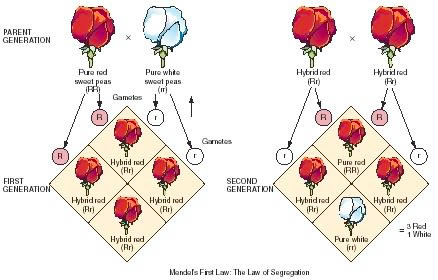Gregor Mendel and the birth of Modern Genetics
During the 1860's an Austrian monk by the name of Gregor Mendel conducted a series of experiments with true breeding strains (a strain that when self fertilized produces the same traits) of garden peas. From his experiments Mendel concluded that the color variation found in garden peas was controlled by what he called a pair of "factors" --what we now call genes. The factor, or genes, that control each trait occur in alternate forms
 |
called alleles. Each allele is capable of producing certain variations of the given trait, for example the red and white color garden peas. Mendel was able to arrive at these conclusion after a series of experiments in which he crossbred red and white true breeding strains.
For example consider the image above. Mendel began his experiment by cross breeding a red garden pea with white garden pea. The resulting seeds all yielded first generation red garden peas. Mendel then crossbred the all red first generation garden peas which yeiled the second generation garden peas. To Mendel's surpriseone quarter of this second generation pea produced white flowers.
From these expeiments Mendel concluded that some alleles are dominant while others are recessive; in this case the allele for red flowers was dominant over the allele for white flowers. During sexual reproduction each parent contributes one allele to the offspring. In Mendels experiments the parent generation of red garden peas, since it was a true breeding strain, contained two allele for red flowers (designated as RR): the white garden peas, for the same reason, contained two alleles for white flowers (designated as rr). Since each parent can only contribute two different allles there are four possible combinations of alleles that the offspring can inherit: Rr, Rr, rR, rR. Since this first generation produce all red flowers Mendel deduced that the red allele must be dominant over the white. The second generation can also only inherit four possible combinations of alleles. This time however the parent (hybrid) generation each contains one allele for red and one for white and can therefore combine to produce the following allele combinations: RR, Rr, rR, rr. In this generation only the offspring that inherited both recessive alleles produced the recessive trait, in this case white flowers.
Mendels experiments showed that genes do not blend during inheritance but are transmitted as discreet entities. Furthermore Mendel showed that although some variation may not appear in a given generation it is not lost to the population. Mendel's experiment finally provided a mechanism for inheritance and therfore a path for evolution.
